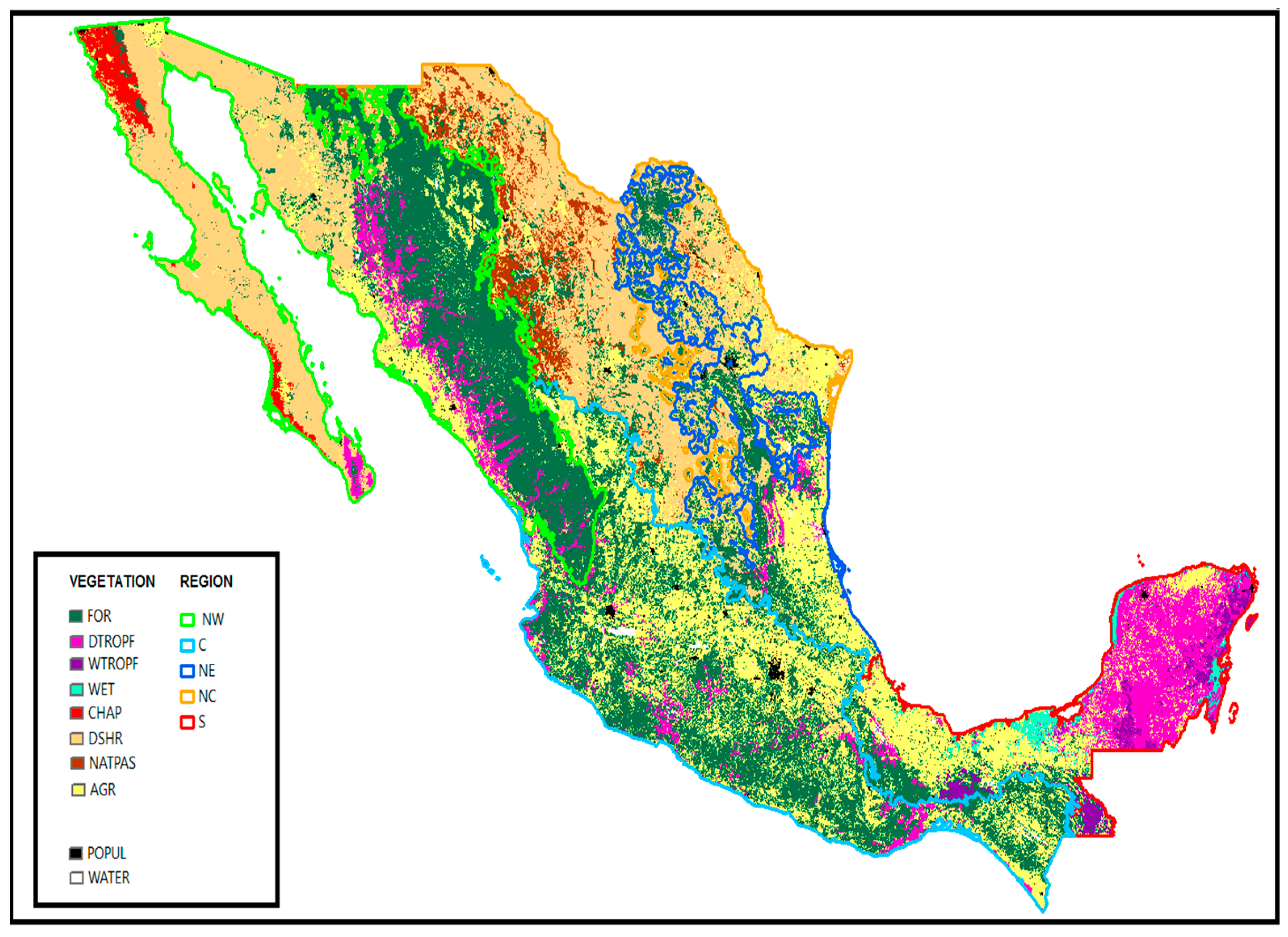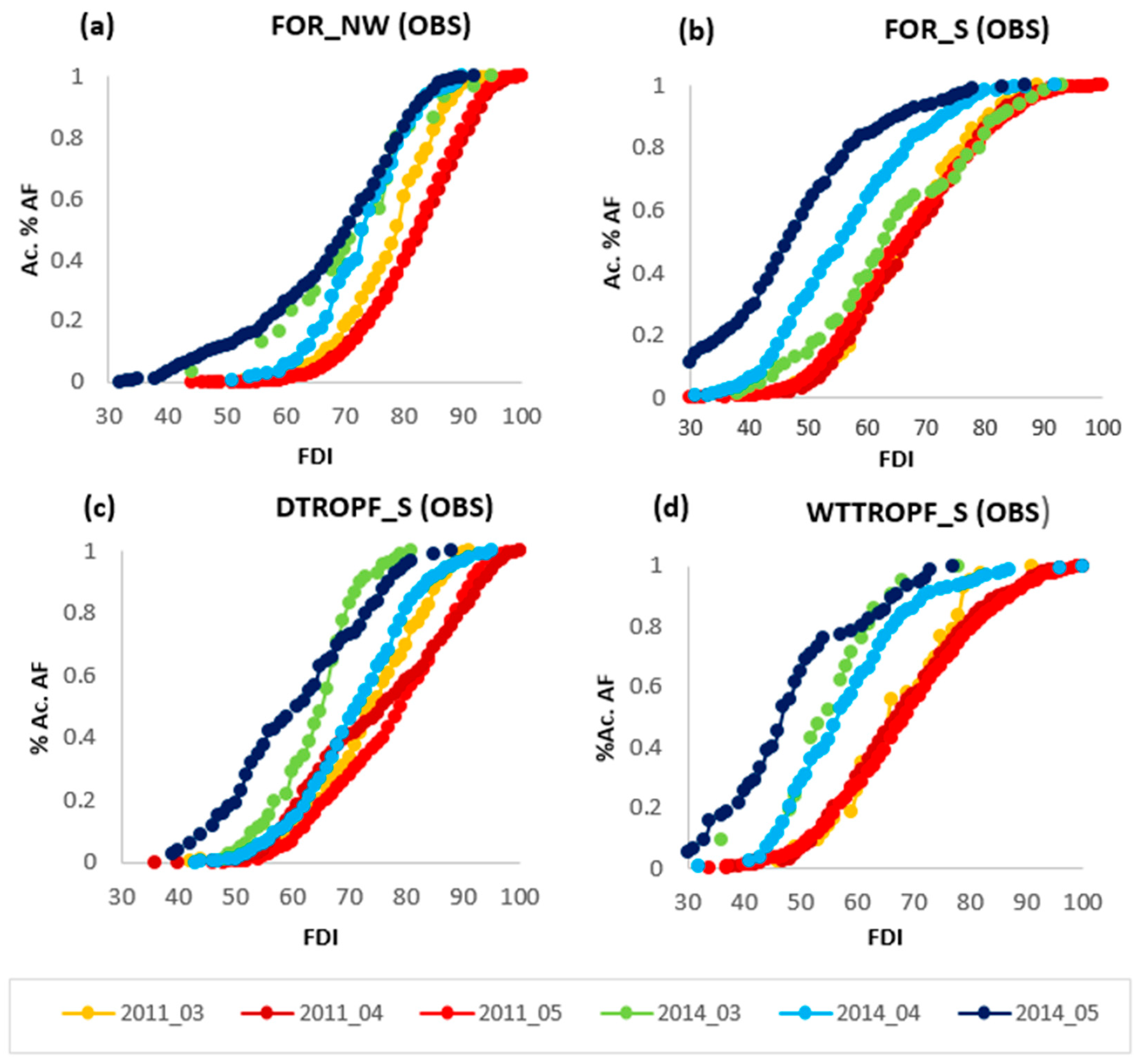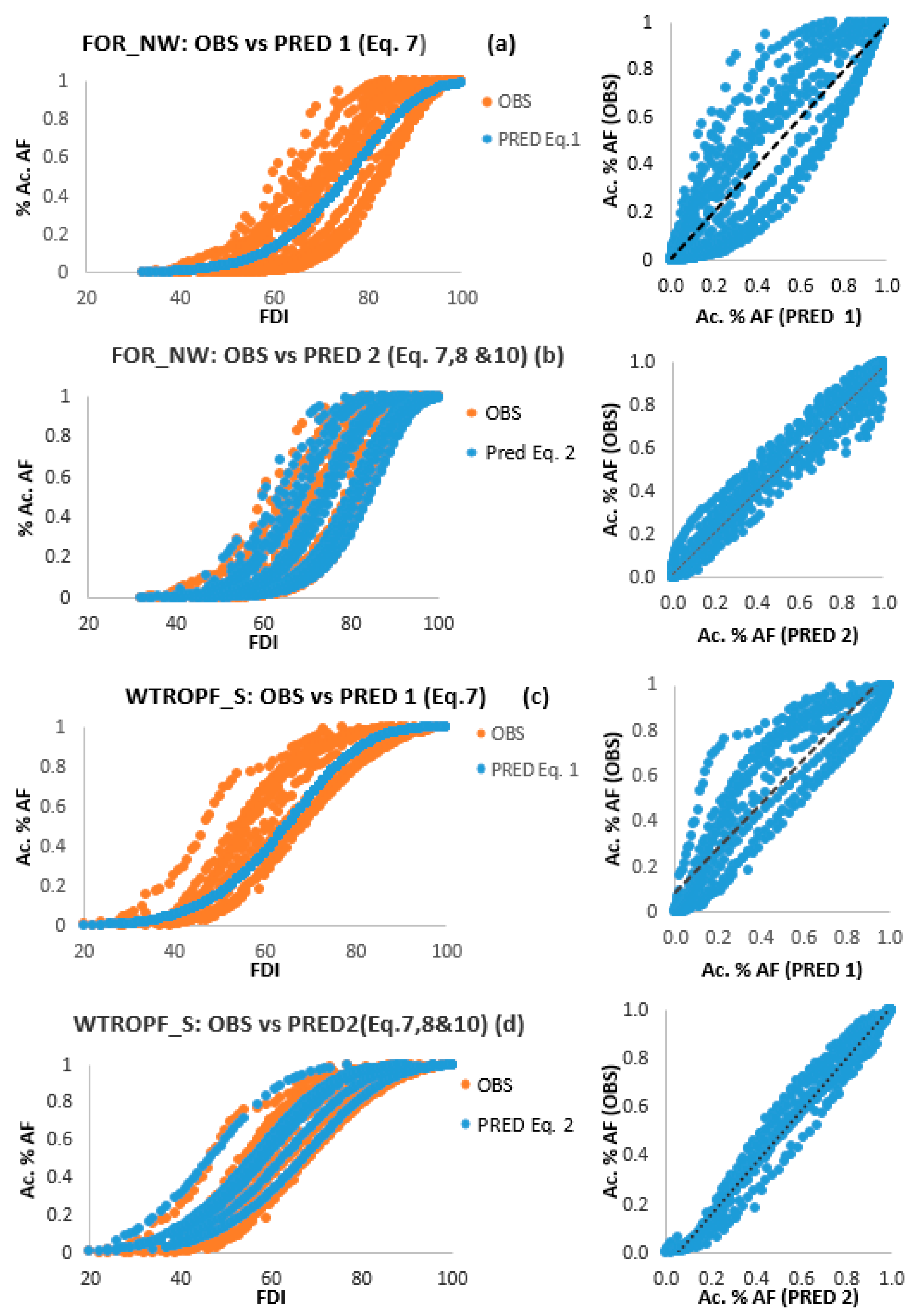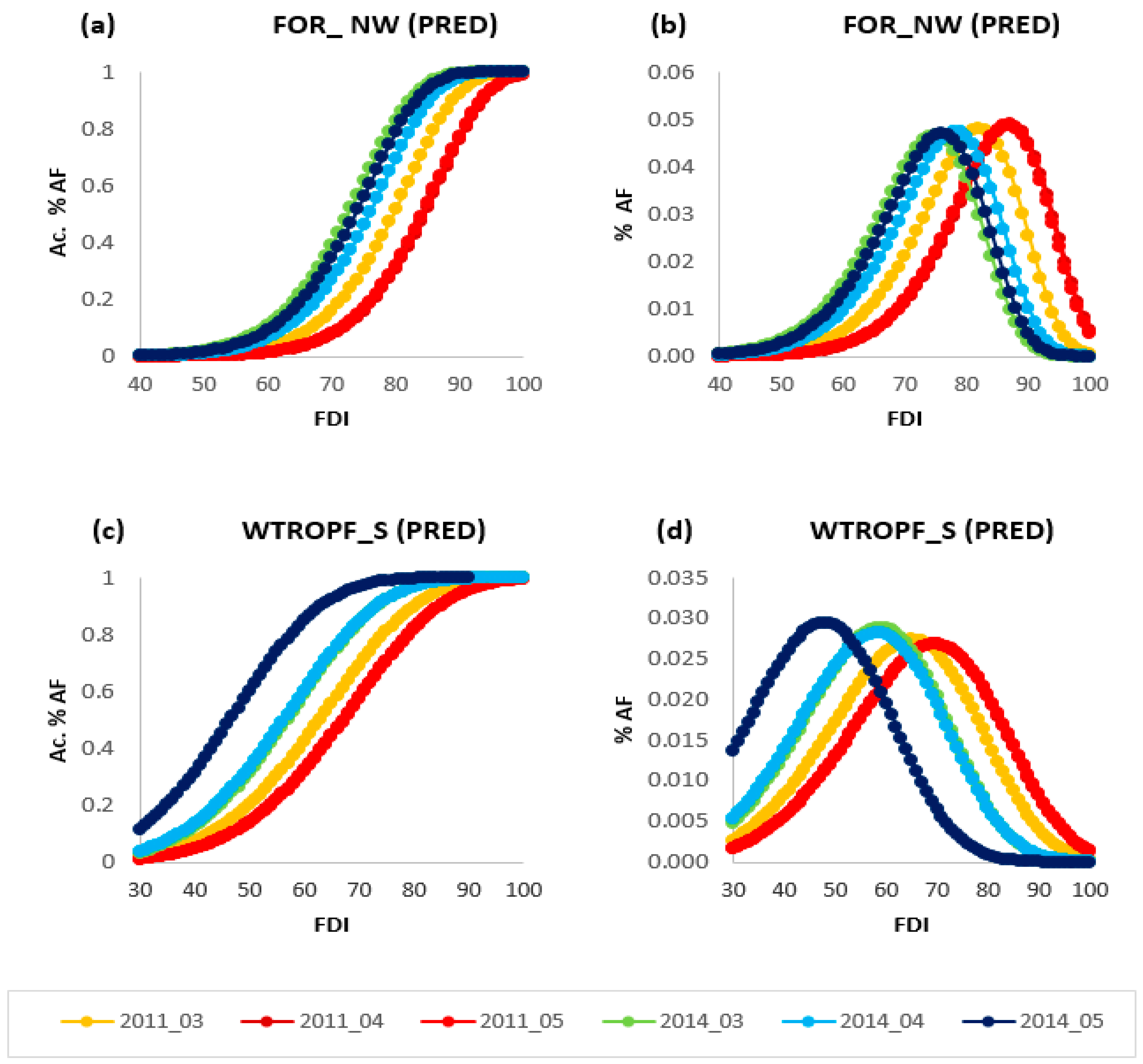Modeling the Monthly Distribution of MODIS Active Fire Detections from a Satellite-Derived Fuel Dryness Index by Vegetation Type and Ecoregion in Mexico
Abstract
:1. Introduction
2. Materials and Methods
2.1. Study Area
2.2. Fuel Dryness Index Inputs
2.3. Fuel Dryness Index (FDI) Calculation
2.4. Observed Monthly Number and Percentage of Active Fires by FDI Values
2.5. Modeling the Accumulated % AF from FDI Values
3. Results
3.1. Observed % AF Distributions by FDI Value
3.2. Predicted % AF Distributions
4. Discussion
5. Conclusions
Author Contributions
Funding
Institutional Review Board Statement
Informed Consent Statement
Data Availability Statement
Acknowledgments
Conflicts of Interest
References
- Liu, Z.; Yang, J.; Chang, Y.; Weisberg, P.J.; He, H.S. Spatial Patterns and Drivers of Fire Occurrence and Its Future Trend under Climate Change in a Boreal Forest of Northeast China. Glob. Chang. Biol. 2012, 18, 2041–2056. [Google Scholar] [CrossRef]
- Finney, M.A. The Challenge of Quantitative Risk Analysis for Wildland Fire. For. Ecol. Manag. 2005, 211, 97–108. [Google Scholar] [CrossRef]
- Hering, A.S.; Bell, C.L.; Genton, M.G. Modeling Spatiotemporal Wildfire Ignition Point Patterns. Environ. Ecol. Stat. 2009, 16, 225–250. [Google Scholar] [CrossRef]
- Yang, J.; He, H.S.; Shifley, S.R.; Gustafson, E.J. Spatial patterns of modern period human-caused fire occurrence in the Missouri Ozark Highlands. For. Sci. 2007, 53, 1–15. [Google Scholar]
- Chang, Y.; Zhu, Z.L.; Bu, R.C.; Chen, H.W.; Feng, Y.T.; Li, Y.H.; Hu, Y.M.; Wang, Z.C. Predicting fire occurrence patterns with logistic regression in Heilongjiang Province, China. Landsc. Ecol. 2013, 28, 1989–2004. [Google Scholar] [CrossRef]
- Schneider, P.; Roberts, D.A.; Kyriakidis, P.C. A VARI-based relative greenness from MODIS data for computing the fire potential index. Remote Sens. Environ. 2008, 112, 1151–1167. [Google Scholar] [CrossRef]
- Preisler, H.K.; Westerling, A.L.; Gebert, K.M.; Munoz-Arriola, F.; Holmes, T.P. Spatially explicit forecasts of large wildland fire probability and suppression costs for California. Int. J. Wildland Fire 2011, 20, 508–517. [Google Scholar] [CrossRef]
- Mavsar, R.; González-Cabán, A.; Varela, E. The State of Development of Fire Management Decision Support Systems in America and Europe. For. Policy Econ. 2013, 29, 45–55. [Google Scholar] [CrossRef]
- Elia, M.; Giannico, V.; Lafortezza, R.; Sanesi, G. Modeling Fire Ignition Patterns in Mediterranean Urban Interfaces. Stoch. Environ. Res. Risk Assess. 2019, 33, 169–181. [Google Scholar] [CrossRef]
- Jolly, W.M.; Cochrane, M.A.; Freeborn, P.H.; Holden, Z.A.; Brown, T.J.; Williamson, G.J.; Bowman, D.M. Climate-Induced Variations in Global Wildfire Danger from 1979 to 2013. Nat. Commun. 2015, 6, 7537. [Google Scholar] [CrossRef]
- Podschwit, H.R.; Larkin, N.K.; Steel, E.A.; Cullen, A.; Alvarado, E. Multi-Model Forecasts of Very-Large Fire Occurrences during the End of the 21st Century. Climates 2018, 6, 100. [Google Scholar] [CrossRef]
- Dupuy, J.L.; Fargeon, H.; Martin-StPaul, N.; Pimont, F.; Ruffault, J.; Guijarro, M.; Hernando, C.; Madrigal, J.; Fernandes, P. Climate Change Impact on Future Wildfire Danger and Activity in Southern Europe: A Review. Ann. For. Sci. 2020, 77, 35. [Google Scholar] [CrossRef]
- Urbieta, I.R.; Zavala, G.; Bedia, J.; Gutiérrez, J.M.; San Miguel-Ayanz, J.; Camia, A.; Keeley, J.E.; Moreno, J.M. Fire activity as a function of fire–weather seasonal severity and antecedent climate across spatial scales in southern Europe and Pacific western USA. Environ. Res. Lett. 2015, 10, 114013. [Google Scholar] [CrossRef]
- Keyser, A.; Westerling, A. Climate Drives Inter-Annual Variability in Probability of High-Severity Fire Occurrence in the Western United States. Environ. Res. Lett. 2017, 12, 065003. [Google Scholar] [CrossRef]
- Jolly, W.M.; Freeborn, P.H.; Page, W.G.; Butler, B.W. Severe Fire Danger Index: A Forecastable Metric to Inform Firefighter and Community Wildfire Risk Management. Fire 2019, 2, 47. [Google Scholar] [CrossRef]
- Oliveira, S.; Pereira, J.M.C.; San Miguel-Ayanz, J.; Lourenço, L. Exploring the Spatial Patterns of Fire Density in Southern Europe Using Geographically Weighted Regression. Appl. Geogr. 2014, 51, 143–157. [Google Scholar] [CrossRef]
- Parisien, M.A.; Parks, S.A.; Krawchuk, M.A.; Little, J.M.; Flannigan, M.D.; Gowman, L.M.; Moritz, M.A. An Analysis of Controls on Fire Activity in Boreal Canada: Comparing Models Built with Different Temporal Resolutions. Ecol. Appl. 2014, 24, 1341–1356. [Google Scholar] [CrossRef]
- Parks, S.A.; Parisien, M.A.; Miller, C.; Dobrowski, S.Z. Fire Activity and Severity in the Western US Vary Along Proxy Gradients Representing Fuel Amount and Fuel Moisture. PLoS ONE 2014, 9, e99699. [Google Scholar] [CrossRef]
- Díaz-Avalos, C.; Peterson, D.L.; Alvarado, E.; Ferguson, S.A.; Besag, J.E. Space–Time Modelling of Lightning-Caused Ignitions in the Blue Mountains, Oregon. Can. J. For. Res. 2001, 31, 1579–1593. [Google Scholar]
- Littell, J.S.; McKenzie, D.; Peterson, D.L.; Westerling, A.L. Climate and Wildfire Area Burned in Western U.S. Ecoprovinces, 1916–2003. Ecol. Appl. 2009, 19, 1003–1021. [Google Scholar] [CrossRef]
- Cardil, A.; Salis, M.; Spano, D.; Delogu, G.; Molina Terrén, D. Large wildland fires and extreme temperatures in Sardinia (Italy). iForest Biogeosci. For. 2014, 7, 162–169. [Google Scholar] [CrossRef]
- Di Giuseppe, F.; Pappenberger, F.; Wetterhall, F.; Krzeminski, B.; Camia, A.; Libertá, G.; San Miguel, J. The Potential Predictability of Fire Danger Provided by Numerical Weather Prediction. J. Appl. Meteorol. Climatol. 2016, 55, 2469–2491. [Google Scholar] [CrossRef]
- Jolly, W.M.; Freeborn, P.H. Towards Improving Wildland Firefighter Situational Awareness through Daily Fire Behaviour Risk Assessments in the US Northern Rockies and Northern Great Basin. Int. J. Wildland Fire 2017, 26, 574–586. [Google Scholar] [CrossRef]
- Sirca, C.; Salis, M.; Arca, B.; Duce, P.; Spano, D. Assessing the performance of fire danger indexes in a Mediterranean area. iForest Biogeosci. For. 2018, 11, 563–571. [Google Scholar] [CrossRef]
- Yebra, M.; Dennison, P.; Chuvieco, E.; Riaño, D.; Zylstra, P.; Hunt, R.; Danson, F.M.; Qi, Y.; Jurdao, S. A global review of remote sensing of live fuel moisture content for fire danger assessment: Moving towards operational products. Remote Sens. Environ. 2013, 136, 455–468. [Google Scholar] [CrossRef]
- Molaudzi, O.D.; Adelabu, S.A. Review of the Use of Remote Sensing for Monitoring Wildfire Risk Conditions to Support Fire Risk Assessment in Protected Areas. S. Afr. J. Geomat. 2019, 7, 222–242. [Google Scholar] [CrossRef]
- Marino, E.; Yebra, M.; Guillén-Climent, M.; Algeet, N.; Tomé, J.L.; Madrigal, J.; Guijarro, M.; Hernando, C. Investigating Live Fuel Moisture Content Estimation in Fire-Prone Shrubland from Remote Sensing Using Empirical Modelling and RTM Simulations. Remote Sens. 2020, 12, 2251. [Google Scholar] [CrossRef]
- Lozano, F.J.; Suárez-Seoane, S.; De Luis, E. Assessment of Several Spectral Indices Derived from Multi-Temporal Landsat Data for Fire Occurrence Probability Modelling. Remote Sens. Environ. 2007, 107, 533–544. [Google Scholar] [CrossRef]
- Lozano, F.J.; Suarez-Seoane, S.; Luis, E. A Multi-Scale Approach for Modeling Fire Occurrence Probability Using Satellite Data and Classification Trees: A Case Study in a Mountainous Mediterranean Region. Remote Sens. Environ. 2008, 112, 708–719. [Google Scholar] [CrossRef]
- Lasaponara, R.; Aromando, A.; Cardettini, G.; Proto, M. Fire Risk Estimation at Different Scales of Observations: An Overview of Satellite Based Methods. In International Conference on Computational Science and Its Applications; Gervasi, O., Murgante, B., Sanjay Misra, S., Stankova, E., Torre, C.M., Rocha, A.M., Taniar, D., Apduhan, B.O., Tarantino, E., Yeonseung Ryu, Y., Eds.; Springer International Publishing AG: Berlin/Heidelberg, Germany, 2018; pp. 375–388. [Google Scholar] [CrossRef]
- García, M.; Riaño, D.; Yebra, M.; Salas, J.; Cardil, A.; Monedero, S.; Ramirez, J.; Martín, M.P.; Vilar, L.; Gajardo, J.; et al. A Live Fuel Moisture Content Product from Landsat TM Satellite Time Series for Implementation in Fire Behavior Models. Remote Sens. 2020, 12, 1714. [Google Scholar] [CrossRef]
- Burgan, R.E.; Klaver, R.W.; Klaver, J.M. Fuel Models and Fire Potential from Satellite and Surface Observations. Int. J. Wildland Fire 1998, 8, 159–170. [Google Scholar] [CrossRef]
- Fiorucci, P.; Gaetani, F.; Lanorte, A.; Lasaponara, R. Dynamic Fire Danger Mapping from Satellite Imagery and Meteorological Forecast Data. Earth Interact. 2007, 11, 1–17. [Google Scholar] [CrossRef]
- Preisler, H.K.; Burgan, R.E.; Eidenshink, J.C.; Klaver, J.M.; Klaver, R.W. Forecasting Distributions of Large Federal-Lands Fires Utilizing Satellite And Gridded Weather Information. Int. J. Wildland Fire 2009, 18, 508–516. [Google Scholar] [CrossRef]
- Sebastián-Lopez, A.; San-Miguel-Ayanz, J.; Burgan, R.E. Integration of satellite sensor data, fuel type maps and meteorological observations for evaluation of forest fire risk at the pan-European scale. Int. J. Remote Sens. 2002, 23, 2713–2719. [Google Scholar] [CrossRef]
- Huesca, M.; Litago, J.; Palacios-Orueta, A.; Montes, F.; Sebastián-López, A.; Escribano, P. Assessment of Forest Fire Seasonality Using MODIS Fire Potential: A Time Series Approach. Agric. For. Meteorol. 2009, 149, 1946–1955. [Google Scholar] [CrossRef]
- Huesca, M.; Litago, J.; Merino-de-Miguel, S.; Cicuendez-López-Ocaña, V.; Palacios-Orueta, A. Modeling and Forecasting MODIS-Based Fire Potential Index on a Pixel Basis Using Time Series Models. Int. J. Appl. Earth Obs. Geoinf. 2014, 26, 363–376. [Google Scholar] [CrossRef]
- Ramamoorthy, T.P.; Bye, R.; Lot, A.; Fa, J. (Eds.) Biological Diversity of Mexico: Origins and Distribution; Oxford University Press: New York, NY, USA, 1993. [Google Scholar]
- CONABIO. La Diversidad Biológica de México. Estudio de País; Comisión Nacional para el Conocimiento y Uso de la Biodiversidad: Mexico City, Mexico, 1998; 350p, ISBN 970-900-03-9. [Google Scholar]
- Vega-Nieva, D.J.; Briseño-Reyes, J.; Nava-Miranda, M.G.; Calleros-Flores, E.; López-Serrano, P.M.; Corral-Rivas, J.J.; Montiel-Antuna, E.; Cruz-López, M.I.; Cuahutle, M.; Ressl, R.; et al. Developing Models to Predict the Number of Fire Hotspots from an Accumulated Fuel Dryness Index by Vegetation Type and Region in Mexico. Forests 2018, 9, 190. [Google Scholar] [CrossRef]
- Briones-Herrera, C.I.; Vega-Nieva, D.J.; Monjarás-Vega, N.A.; Flores-Medina, F.; Lopez-Serrano, P.M.; Corral-Rivas, J.J.; Carrillo-Parra, A.; Pulgarin-Gámiz, M.A.; Alvarado-Celestino, E.; González-Cabán, A.; et al. Modeling and mapping forest fire occurrence from aboveground carbon density in Mexico. Forests 2019, 10, 402. [Google Scholar] [CrossRef]
- Monjarás-Vega, N.A.; Briones-Herrera, C.I.; Vega-Nieva, D.J.; Calleros-Flores, E.; Corral-Rivas, J.J.; López-Serrano, P.M.; Pompa-García, M.; Rodríguez-Trejo, D.A.; Carrillo-Parra, A.; González-Cabán, A.; et al. Predicting Forest Fire Kernel Density at Multiple Scales with Geographically Weighted Regression in Mexico. Sci. Total Environ. 2020, 718, 137313. [Google Scholar] [CrossRef]
- Avila-Flores, D.; Pompa-García, M.; Antonio-Nemiga, X.; Rodríguez-Trejo, D.A.; Vargas-Perez, E.; Santillan-Pérez, J. Driving factors for forest fire occurrence in Durango State of Mexico: A geospatial perspective. Chin. Geogr. Sci. 2010, 20, 491–497. [Google Scholar] [CrossRef]
- Carrillo García, R.L.; Rodríguez Trejo, D.A.; Tchikoué, H.; Monterroso Rivas, A.I.; Santillan Pérez, J. Análisis espacial de peligro de incendios forestales en Puebla, México. Interciencia 2012, 37, 678–683. [Google Scholar]
- Cruz-López, M.I.; Manzo-Delgado, L.D.L.; Aguirre-Gómez, R.; Chuvieco, E.; Equihua-Benítez, J.A. Spatial distribution of forest fire emissions: A case study in three Mexican ecoregions. Remote Sens. 2019, 11, 1185. [Google Scholar] [CrossRef]
- Muñoz, C.A.; Treviño, E.J.; Verástegui, J.; Jiménez, J.; Aguirre, O.A. Desarrollo de un Modelo Espacial para la Evaluación del Peligro de Incendios Forestales en la Sierra Madre Oriental de México. Investig. Geogr. 2005, 56, 101–117. [Google Scholar]
- Pérez-Verdin, G.; Márquez-Linares, M.A.; Cortes-Ortiz, A.; Salmerón-Macias, M. Análisis espacio-temporal de la ocurrencia de incendios forestales en Durango, México. Madera Y Bosques 2013, 19, 37–58. [Google Scholar] [CrossRef]
- Antonio, X.; Ellis, E.A. Forest Fires and Climate Correlation in Mexico State: A Report Based on MODIS. Adv. Remote Sens. 2015, 4, 280–286. [Google Scholar] [CrossRef]
- Ibarra-Montoya, J.L.; Huerta-Martínez, F.M. Modelado Espacial de Incendios: Una Herramienta Predictiva para el Bosque La Primavera, Jalisco México. Ambiente Água 2016, 11, 36–51. [Google Scholar] [CrossRef]
- Manzo-Delgado, L.; Sánchez-Colón, S.; Álvarez, R. Assessment of Seasonal Forest Fire Risk Using NOAA-AVHRR: A Case Study in Central Mexico. Int. J. Remote Sens. 2009, 30, 4991–5013. [Google Scholar] [CrossRef]
- Manzo-Delgado, L.; Aguirre-Gómez, R.; Álvarez, R. Multitemporal Analysis of Land Surface Temperature Using NOAA-AVHRR: Preliminary Relationships between Climatic Anomalies and Forest Fires. Int. J. Remote Sens. 2004, 25, 4417–4423. [Google Scholar] [CrossRef]
- Pompa-García, M.; Camarero, J.J.; Rodríguez-Trejo, D.A.; Vega-Nieva, D.J. Drought and spatiotemporal variability of forest fires across Mexico. Chin. Geogr. Sci. 2017, 28, 25–37. [Google Scholar]
- Zúñiga-Vásquez, J.M.; Cisneros-González, D.; Pompa-García, M. Drought regulates the burned forest areas in Mexico: The case of 2011, a record year. Geocarto Int. 2017, 34, 560–573. [Google Scholar] [CrossRef]
- Vega-Nieva, D.J.; Nava-Miranda, M.G.; Calleros-Flores, E.; López Serrano, P.M.; Briseño-Reyes, J.; López-Sánchez, C.; Corral-Rivas, J.J.; Montiel-Antuna, E.; Cruz-Lopez, M.I.; Ressl, R.; et al. Temporal patterns of active fire density and its relationship with a satellite fuel greenness index by vegetation type and region in Mexico during 2003–2014. Fire Ecol. 2019, 15, 28. [Google Scholar] [CrossRef]
- Preisler, H.K.; Eidenshink, J.; Howard, S.; Burgan, R.E. Forecasting Distribution of Numbers of Large Fires. In Proceedings of the Fires Conference, Sharpsburg, GA, USA, 18–20 May 2015. [Google Scholar]
- Sebastián López, A.; Burgan, R.E.; Calle, A.; Palacios-Orueta, A. Calibration of the fire potential index in different seasons and bioclimatic regions of southern Europe. In Proceedings of the 4a Conferencia Internacional Sobre Incendios Forestales, Seville, Spain, 13–18 May 2007; Organismo Autónomo de Parques Nacionales, Ministerio del Medio Ambiente: Sevilla, Spain, 2007. [Google Scholar]
- Huesca, M.; Palacios-Orueta, A.; Montes, F.; Sebastián-López, A.; Escribano, P. Forest Fire Potential Index for Navarra Autonomic Community (Spain). In Proceedings of the 4th Wildland Fire International Conference, Sevilla, Spain, 14–17 May 2007. [Google Scholar]
- Fosberg, M.A. Moisture Content Calculations for the 100-Hour Timelag Fuel in Fire Danger Rating; Research Note RM-199; USDA Forest Service, Rocky Mountain Forest and Range Experimental Station: Fort Collins, CO, USA, 1971.
- Cervera-Taboada, A. Implementación de un Modelo para Estimar la Humedad en el Combustible Muerto, Basado en Datos de Sensores Remotos. Bachelor’s Thesis, Universidad Nacional Autónoma de México, Mexico City, Mexico, 2009; p. 175. [Google Scholar]
- Cruz-Lopez, M.I.; Ressl, R. The National National System for Satellite based real-time wildfire monitoring. In Proceedings of the 5th International Wildland Fire Conference, Sun City, South Africa, 9–13 May 2011. [Google Scholar]
- Giglio, L.; Descloitres, J.; Justice, C.O.; Kaufman, Y.J. An Enhanced Contextual Fire Detection Algorithm for MODIS. Remote Sens. Environ. 2003, 87, 273–282. [Google Scholar] [CrossRef]
- Cruz-Lopez, M.I. Sistema de alerta temprana, monitoreo e impacto de los incendios forestales en México y Centroamérica. In Proceedings of the 4th Wildland Fire International Conference, Sevilla, Spain, 14–17 May 2007. [Google Scholar]
- Ryan, T.P. Modern Regression Methods; Wiley Series in Probability and Statistics; John Wiley and Sons: New York, NY, USA, 1997. [Google Scholar]
- Woolford, D.G.; Braun, W.J.; Dean, C.B.; Martell, D.L. Site-specific seasonal baselines for fire risk in Ontario. Geomatica 2009, 63, 355–363. [Google Scholar]
- Nolan, R.H.; Boer, M.M.; Resco de Dios, V.; Caccamo, G.; Bradstock, R.A. Large-Scale, Dynamic Transformations in Fuel Moisture Drive Wildfire Activity across Southeastern Australia. Geophys. Res. Lett. 2016, 43, 4229–4238. [Google Scholar] [CrossRef]
- Duff, T.J.; Cawson, J.G.; Harris, S. Dryness Thresholds for Fire Occurrence Vary by Forest Type along an Aridity Gradient: Evidence from Southern Australia. Landsc. Ecol. 2018, 33, 1369–1383. [Google Scholar] [CrossRef]
- Rodríguez-Trejo, D.A.; Ramírez, H.; Tchikoué, H.; Santillán, J. Factores que inciden en la siniestralidad de los incendios forestales. Cienc. For. 2008, 33, 37–58. [Google Scholar]
- Flores-Garnica, J.G.; Reyes-Alvarado, A.; Reyes-Cárdenas, O. Relación Espaciotemporal de Puntos de Calor con Superficies Agropecuarias y Forestales en San Luis Potosí, México. Rev. Mex. Cienc. For. 2021, 12, 127–145. [Google Scholar] [CrossRef]
- Pausas, J.G.; Paula, S. Fuel Shapes the Fire-Climate Relationship: Evidence from Mediterranean Ecosystems. Glob. Ecol. Biogeogr. 2012, 11, 1074–1082. [Google Scholar] [CrossRef]
- Cruz-López, M.I. Implementación de las Técnicas de Percepción Remota para el Conocimiento y Uso de la Biodiversidad. Informe Académico por Experiencia o Práctica Profesional; Universidad Nacional Autónoma de México: Mexico City, Mexico, 2008; p. 111. [Google Scholar]
- Cruz-Lopez, M.I. Sistema de Alerta Temprana, Monitoreo y Respuesta para la Prevención de Incendios Forestales en la Reserva de la Biosfera El Triunfo, Chiapas. Master’s Thesis, Universidad Nacional Autónoma de México, Mexico City, Mexico, 2012; p. 74. [Google Scholar]
- Martell, D.L.; Bevilacqua, E. Modelling Seasonal Variation in Daily People-Caused Forest Fire Occurrence. Can. J. For. Res. 1989, 19, 1555–1563. [Google Scholar] [CrossRef]
- Martell, D.L.; Otukol, S.; Stocks, B.J. A Logistic Model for Predicting Daily People-Caused Forest Fire Occurrence in Ontario. Can. J. For. Res. 1987, 17, 394–401. [Google Scholar] [CrossRef]
- Woolford, D.G.; Bellhouse, D.R.; Braun, W.J.; Dean, C.B.; Martell, D.L.; Sun, J. A spatio-temporal model for people-caused forest fire occurrence in the Romeo Malette Forest. J. Environ. Stat. 2011, 2, 2–16. [Google Scholar]
- Woolford, D.G.; Dean, C.B.; Martell, D.L.; Cao, J.; Wotton, B.M. Lightning-caused forest fire risk in Northwestern Ontario, Canada is increasing and associated with anomalies in fire-weather. Environmetrics 2014, 25, 406–416. [Google Scholar] [CrossRef]
- Yunhao, C.; Li, J.; Guangxiong, P. Forest fire risk assessment combining remote sensing and meteorological information. N. Z. J. Agric. Res. 2007, 50, 1037–1044. [Google Scholar] [CrossRef]
- Krawchuk, M.; Moritz, M. Constraints on Global Fire Activity Vary Across a Resource Gradient. Ecology 2011, 92, 121–132. [Google Scholar] [CrossRef] [PubMed]
- Bradstock, R.A. A biogeographic model of fire regimes in Australia: Current and future implications. Glob. Ecol. Biogeogr. 2010, 19, 145–158. [Google Scholar] [CrossRef]
- Papakosta, P.; Straub, D. Probabilistic Prediction of Daily Fire Occurrence in the Mediterranean with Readily Available Spatio-Temporal Data. iForest Biogeosci. For. 2016, 10, 32–40. [Google Scholar] [CrossRef]
- Ager, A.A.; Barros, A.M.G.; Day, M.A.; Preisler, H.K.; Spies, T.A.; Bolte, J. Analyzing fine-scale spatiotemporal drivers of wildfire in a forest landscape model. Ecol. Model. 2018, 384, 87–102. [Google Scholar] [CrossRef]
- Ager, A.A.; Preisler, H.K.; Arca, B.; Spano, D.; Salis, M. Wildfire Risk Estimation in the Mediterranean Area. Environmetrics 2014, 25, 384–396. [Google Scholar] [CrossRef]




| Best Fit Coefficients | Goodness of Fit | |||||
|---|---|---|---|---|---|---|
| Veg_reg | b1 | b2 | c1 | c2 | RMSE | R2adj |
| FOR_C | 0.79 | 23.17 | 0.085 | 1.059 | 0.06 | 0.972 |
| FOR_S | 0.80 | 18.78 | 0.134 | 0.829 | 0.05 | 0.977 |
| FOR_NC | 0.35 | 51.98 | 0.077 | 1.150 | 0.13 | 0.862 |
| FOR_NE | 0.84 | 14.40 | 0.091 | 0.978 | 0.10 | 0.917 |
| FOR_NW | 0.83 | 15.88 | 0.104 | 1.055 | 0.06 | 0.968 |
| D&W_TROPF_S | 0.81 | 20.47 | 0.621 | 0.510 | 0.08 | 0.954 |
| DTROPF_C | 0.95 | 11.27 | 0.385 | 0.726 | 0.11 | 0.902 |
| DTROPF_NW | 0.90 | 11.22 | 0.083 | 1.173 | 0.09 | 0.935 |
| DTROPF_NE | 0.77 | 20.78 | 0.581 | 0.564 | 0.11 | 0.880 |
| CHAP__NW | 0.08 | 69.27 | 0.159 | 0.842 | 0.09 | 0.928 |
| AGR_C | 0.85 | 19.66 | 0.050 | 1.190 | 0.10 | 0.919 |
| AGR_S | 0.96 | 10.03 | 0.283 | 0.664 | 0.06 | 0.977 |
| AGR_NE | 1.03 | 3.88 | 0.129 | 0.920 | 0.06 | 0.967 |
| AGR_NW | 0.48 | 46.05 | 0.714 | 0.587 | 0.09 | 0.929 |
| AGR_NC | 0.88 | 14.77 | 0.092 | 1.080 | 0.07 | 0.945 |
| WET_S | 1.07 | 3.24 | 0.048 | 1.202 | 0.13 | 0.863 |
| DSHR_&NPAS | 0.68 | 31.35 | 0.039 | 1.258 | 0.17 | 0.741 |
Disclaimer/Publisher’s Note: The statements, opinions and data contained in all publications are solely those of the individual author(s) and contributor(s) and not of MDPI and/or the editor(s). MDPI and/or the editor(s) disclaim responsibility for any injury to people or property resulting from any ideas, methods, instructions or products referred to in the content. |
© 2023 by the authors. Licensee MDPI, Basel, Switzerland. This article is an open access article distributed under the terms and conditions of the Creative Commons Attribution (CC BY) license (https://creativecommons.org/licenses/by/4.0/).
Share and Cite
Vega-Nieva, D.J.; Nava-Miranda, M.G.; Briseño-Reyes, J.; López-Serrano, P.M.; Corral-Rivas, J.J.; Cruz-López, M.I.; Cuahutle, M.; Ressl, R.; Alvarado-Celestino, E.; Burgan, R.E. Modeling the Monthly Distribution of MODIS Active Fire Detections from a Satellite-Derived Fuel Dryness Index by Vegetation Type and Ecoregion in Mexico. Fire 2024, 7, 11. https://doi.org/10.3390/fire7010011
Vega-Nieva DJ, Nava-Miranda MG, Briseño-Reyes J, López-Serrano PM, Corral-Rivas JJ, Cruz-López MI, Cuahutle M, Ressl R, Alvarado-Celestino E, Burgan RE. Modeling the Monthly Distribution of MODIS Active Fire Detections from a Satellite-Derived Fuel Dryness Index by Vegetation Type and Ecoregion in Mexico. Fire. 2024; 7(1):11. https://doi.org/10.3390/fire7010011
Chicago/Turabian StyleVega-Nieva, Daniel José, María Guadalupe Nava-Miranda, Jaime Briseño-Reyes, Pablito Marcelo López-Serrano, José Javier Corral-Rivas, María Isabel Cruz-López, Martin Cuahutle, Rainer Ressl, Ernesto Alvarado-Celestino, and Robert E. Burgan. 2024. "Modeling the Monthly Distribution of MODIS Active Fire Detections from a Satellite-Derived Fuel Dryness Index by Vegetation Type and Ecoregion in Mexico" Fire 7, no. 1: 11. https://doi.org/10.3390/fire7010011






